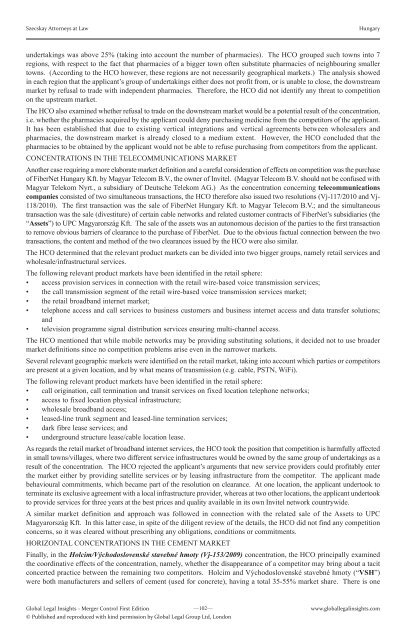Merger Controls First Edition - J Sagar Associates
Merger Controls First Edition - J Sagar Associates
Merger Controls First Edition - J Sagar Associates
You also want an ePaper? Increase the reach of your titles
YUMPU automatically turns print PDFs into web optimized ePapers that Google loves.
Szecskay Attorneys at Law Hungary<br />
undertakings was above 25% (taking into account the number of pharmacies). The HCO grouped such towns into 7<br />
regions, with respect to the fact that pharmacies of a bigger town often substitute pharmacies of neighbouring smaller<br />
towns. (According to the HCO however, these regions are not necessarily geographical markets.) The analysis showed<br />
in each region that the applicant’s group of undertakings either does not profit from, or is unable to close, the downstream<br />
market by refusal to trade with independent pharmacies. Therefore, the HCO did not identify any threat to competition<br />
on the upstream market.<br />
The HCO also examined whether refusal to trade on the downstream market would be a potential result of the concentration,<br />
i.e. whether the pharmacies acquired by the applicant could deny purchasing medicine from the competitors of the applicant.<br />
It has been established that due to existing vertical integrations and vertical agreements between wholesalers and<br />
pharmacies, the downstream market is already closed to a medium extent. However, the HCO concluded that the<br />
pharmacies to be obtained by the applicant would not be able to refuse purchasing from competitors from the applicant.<br />
CONCENTRATIONS IN THE TELECOMMUNICATIONS MARKET<br />
Another case requiring a more elaborate market definition and a careful consideration of effects on competition was the purchase<br />
of FiberNet Hungary Kft. by Magyar Telecom B.V., the owner of Invitel. (Magyar Telecom B.V. should not be confused with<br />
Magyar Telekom Nyrt., a subsidiary of Deutsche Telekom AG.) As the concentration concerning telecommunications<br />
companies consisted of two simultaneous transactions, the HCO therefore also issued two resolutions (Vj-117/2010 and Vj-<br />
118/2010). The first transaction was the sale of FiberNet Hungary Kft. to Magyar Telecom B.V.; and the simultaneous<br />
transaction was the sale (divestiture) of certain cable networks and related customer contracts of FiberNet’s subsidiaries (the<br />
“Assets”) to UPC Magyarország Kft. The sale of the assets was an autonomous decision of the parties to the first transaction<br />
to remove obvious barriers of clearance to the purchase of FiberNet. Due to the obvious factual connection between the two<br />
transactions, the content and method of the two clearances issued by the HCO were also similar.<br />
The HCO determined that the relevant product markets can be divided into two bigger groups, namely retail services and<br />
wholesale/infrastructural services.<br />
The following relevant product markets have been identified in the retail sphere:<br />
• access provision services in connection with the retail wire-based voice transmission services;<br />
• the call transmission segment of the retail wire-based voice transmission services market;<br />
• the retail broadband internet market;<br />
• telephone access and call services to business customers and business internet access and data transfer solutions;<br />
and<br />
• television programme signal distribution services ensuring multi-channel access.<br />
The HCO mentioned that while mobile networks may be providing substituting solutions, it decided not to use broader<br />
market definitions since no competition problems arise even in the narrower markets.<br />
Several relevant geographic markets were identified on the retail market, taking into account which parties or competitors<br />
are present at a given location, and by what means of transmission (e.g. cable, PSTN, WiFi).<br />
The following relevant product markets have been identified in the retail sphere:<br />
• call origination, call termination and transit services on fixed location telephone networks;<br />
• access to fixed location physical infrastructure;<br />
• wholesale broadband access;<br />
• leased-line trunk segment and leased-line termination services;<br />
• dark fibre lease services; and<br />
• underground structure lease/cable location lease.<br />
As regards the retail market of broadband internet services, the HCO took the position that competition is harmfully affected<br />
in small towns/villages, where two different service infrastructures would be owned by the same group of undertakings as a<br />
result of the concentration. The HCO rejected the applicant’s arguments that new service providers could profitably enter<br />
the market either by providing satellite services or by leasing infrastructure from the competitor. The applicant made<br />
behavioural commitments, which became part of the resolution on clearance. At one location, the applicant undertook to<br />
terminate its exclusive agreement with a local infrastructure provider, whereas at two other locations, the applicant undertook<br />
to provide services for three years at the best prices and quality available in its own Invitel network countrywide.<br />
A similar market definition and approach was followed in connection with the related sale of the Assets to UPC<br />
Magyarország Kft. In this latter case, in spite of the diligent review of the details, the HCO did not find any competition<br />
concerns, so it was cleared without prescribing any obligations, conditions or commitments.<br />
HORIZONTAL CONCENTRATIONS IN THE CEMENT MARKET<br />
Finally, in the Holcim/Východoslovenské stavebné hmoty (Vj-153/2009) concentration, the HCO principally examined<br />
the coordinative effects of the concentration, namely, whether the disappearance of a competitor may bring about a tacit<br />
concerted practice between the remaining two competitors. Holcim and Východoslovenské stavebné hmoty (“VSH”)<br />
were both manufacturers and sellers of cement (used for concrete), having a total 35-55% market share. There is one<br />
Global Legal Insights <strong>Merger</strong> Control <strong>First</strong> <strong>Edition</strong><br />
—102—<br />
© Published and reproduced with kind permission by Global Legal Group Ltd, London<br />
www.globallegalinsights.com


